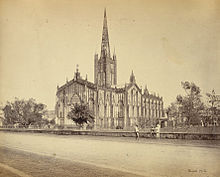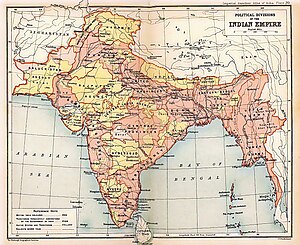The Continuing Anglican movement, also known as the Anglican Continuum, encompasses a number of Christian churches, principally based in North America, that have an Anglican identity and tradition but are not part of the Anglican Communion.
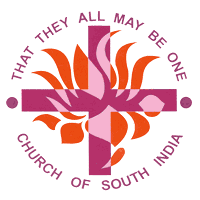
The Church of South India (CSI) is a united Protestant Church in India. It is the result of union of a number of Protestant denominations in South India that occurred after the independence of India.

The Church of North India (CNI) is the dominant united Protestant church in northern India. It was established on 29 November 1970 by bringing together most of the Protestant churches working in northern India. It is a province of the worldwide Anglican Communion and a member of the World Methodist Council and the World Communion of Reformed Churches. The merger, which had been in discussions since 1929, came eventually between the Church of India, Pakistan, Burma and Ceylon (Anglican), the Methodist Church, Disciples of Christ, and some congregations from the United Church of Northern India.

The Church of Bangladesh is a united Protestant church formed by the union of various Protestant churches in Bangladesh, principally the Anglican and Presbyterian denominations. The Church of Bangladesh is a member of the Anglican Communion and the World Communion of Reformed Churches.
The Church of Pakistan is a united Protestant Church in Pakistan founded in 1970; it holds membership in the Anglican Communion, the World Communion of Reformed Churches, and the World Methodist Council.

Bengali Christians are adherents of Christianity among the Bengali people. Christianity took root in Bengal after the arrival of Portuguese voyagers in the 16th century. It witnessed further conversions among the Bengali upper-caste elite during the 19th century Bengali Renaissance.
The Diocese of Calcutta was established in 1813 as part of the Church of England. It is led by the Bishop of Calcutta and the first bishop was Thomas Middleton (1814–1822) and the second Reginald Heber (1823–1826). Under the sixth bishop Daniel Wilson (1832–1858), the see was made Metropolitan when two more dioceses in India came into being.
Protestants in India are a minority and a sub-section of Christians in India and also to a certain extent the Christians in Pakistan before the Partition of India, that adhere to some or all of the doctrines of Protestantism. Protestants in India are a small minority in a predominantly Hindu majority country, but form majorities in the north-eastern states of Meghalaya, Mizoram and Nagaland and significant minorities in Konkan division, Bengal, Kerala and Tamil Nadu, with various communities in east coast and northern states. Protestants today trace their heritage back to the Protestant reformation of the 16th century. There are an estimated 20 million Protestants and 16 million Pentecostals in India.

The Church of the Province of Myanmar in Asia is a member church of the Anglican Communion. The province comprises the entire country of Myanmar. The current archbishop of Myanmar and bishop of Yangon is Stephen Than Myint Oo.
The Diocese of Yangon is the Church of the Province of Myanmar (Anglican) jurisdiction in and around the old capital Yangon, and under the care of the Bishop of Yangon and Archbishop of Myanmar. The diocese was in the Church of England province of Calcutta from 1877 to 1930, then the Church of India, Pakistan, Burma and Ceylon until 1970. Beforehand, British Burma, had come under the guidance of the Bishop of Calcutta, Metropolitan of India. In 1966, the last non-Burmese bishop was evicted by the Burmese authorities and in 1970 the Diocese of Rangoon became the Church of the Province of Burma, and the bishop was elevated to Archbishop in that church.
The Diocese of Mumbai of the Church of North India is the Anglican diocese covering metropolitan Mumbai and the state of Maharashtra. The cathedra seat of the Bishop of Mumbai is St. Thomas Cathedral, Mumbai.

The Church of Ceylon is the Anglican Church in Sri Lanka. It is an extraprovincial jurisdiction of the Archbishop of Canterbury, who serves as its Metropolitan. It was established in 1845 with the appointment of the first Anglican Bishop of Colombo, James Chapman and until 1950 it consisted of a single diocese; in that year a second diocese was established at Kurunegala.
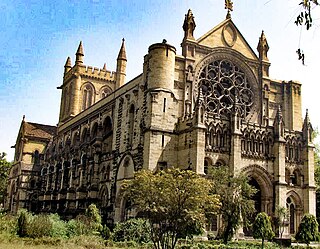
The Diocese of Lucknow is a diocese of the Church of North India, headquartered in the city of Prayagraj. The jurisdiction of the diocese mainly covers the Eastern side of Uttar Pradesh.
The Bishop of Lahore was the Ordinary of the Church of England in Lahore from its inception in 1877 until the foundation of the Church of India, Burma and Ceylon in 1927; and since then head of one of its most prominent Dioceses. Since 1970, the diocese of Lahore has been a part of the Church of Pakistan, a United Protestant denomination.
Most Rev. Lakdasa Jacob De Mel (1902–1976), MA was the first Bishop of Kurunegala, Sri Lanka and the last Metropolitan Archbishop of India, Pakistan, Burma and Ceylon.
The Assembly of Believers' Church In India is a neocharismatic Episcopal denomination in India, rooted in the Saint Thomas Christian tradition and history of Christianity in India. It was established in 1973 by Rev. Reginald Burney Clifford and now contains more than 450 churches with around 40000 members.
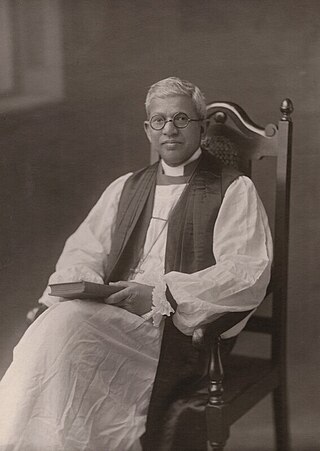
John Sharat Chandra Banerjee was an Anglican assistant bishop in Lahore. He was the second non-European bishop of the Church of India, Burma and Ceylon.
Aurobindo Nath Mukherjee, officially The Most Reverend Aurobindo Nath Mukherjee, was an Indian and Bengali speaking leader of the erstwhile Anglican denomination, known as the Church of India, Pakistan, Burma and Ceylon (1948-1970), which merged with other Protestant denominations to form the Church of North India. He was the fourteenth Bishop of Calcutta and the tenth Metropolitan of India. He was also the first Indian to be either the Bishop of Calcutta or the Metropolitan of India.
Church of India may refer to:

The Church of Bangladesh Metropolitan Diocese of Dhaka is the metropolitan and main diocese of Church of Bangladesh that was erected in 1956 by dividing the Diocese of Calcutta; the diocese was originally called "East Bengal" and covered all of East Pakistan after the partition of India. It was a part of the Anglican Church of India, Pakistan, Burma and Ceylon until the formation of the united Protestant Church of Pakistan in 1970, which merged Lutheran, Anglican, and Presbyterian denominations in that country. It became the sole diocese of the Church of Bangladesh upon the church's 30 April 1974 independence. Since it was split to create Kushtia diocese, the bishop of Dhaka has usually also been moderator and primate of the Church of Bangladesh. The other 2 dioceses of Church of Bangladesh are under its governance.
